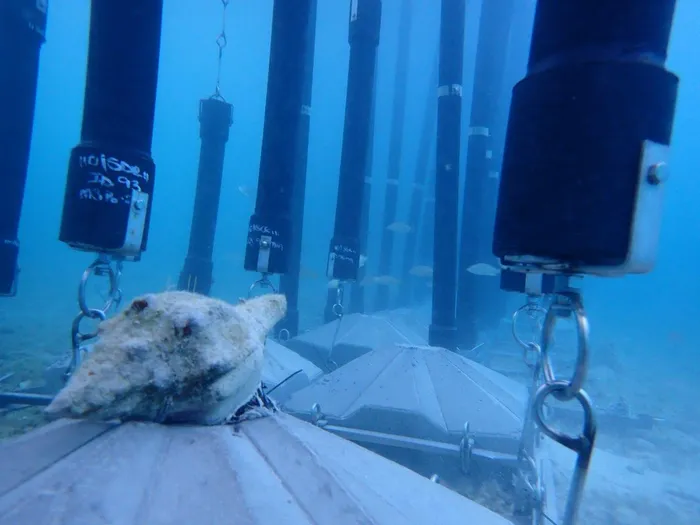Locally developed, eco-friendly shark barrier installed in the Bahamas

A conch exploring the limpet-shaped cement blocks anchoring the new SharkSafe Barrier installation at an island in the Bahamas. This eco-friendly installation mimics the visual effect of a kelp forest, and generates a strong magnetic field through means of ceramic magnets. This forms a double barrier (both visual and magnetic) that keeps sharks at bay. Picture: SharkSafe Barrier
Cape Town - An eco-friendly SharkSafe Barrier, developed by marine biologists at Stellenbosch University (SU), has now been installed at a private island in the Bahamas.
The SharkSafe Barrier mimics a kelp forest with a magnetic field to keep humans and sharks apart without harming the sharks or large marine species.
Dr Sara Andreotti, marine biologist at SU and co-founder of SharkSafe Barrier, said this nature-inspired technology is currently the only eco-friendly alternative to shark nets, which resulted in the death of thousands of sharks and other marine life every year.
The installation of a 30m SharkSafe Barrier at the Berry Islands in August this year will further strengthen marine conservation efforts in the Bahamas.
In 2011, the Bahamas proclaimed the first shark sanctuary in the Atlantic Ocean, and, in 2018, a Marine Action Partnership (MAP) for Sustainable Fisheries. Shark tourism currently contributes about $100 million a year to their local economy.
Andreotti said that since 2012 the technology has undergone rigorous testing in the turbulent ocean waters along the South African coast, as well as in the tropical waters of Reunion Island and the Bahamas. The results from several of these case studies have been published in peer-reviewed scientific journals.
The thinking behind the development of the SharkSafe Barrier concept is a combination of practical experience with sharks and marine biologists’ understanding of their behaviour, she explained.

The SharkSafe Barrier consists of high-density polyethylene pipes manufactured in Maitland.
During installation in the ocean, the buoyant pipes are anchored on a grid-like structure one metre apart from one another, with large ceramic magnets staggered in the ocean-facing row.
The grid is then weighted by limpet-shaped 200kg cement blocks and secured by rock anchors and sand.
Apart from the fact that the SharkSafe Barrier combines two proven shark repellent strategies, it has also been designed to remain in the water for at least 20 years with minimal maintenance required.
For Andreotti, the first commercial installation of the SharkSafe Barrier is the breakthrough that the team has been working towards for the past 15 years.
“We now have the technology to allow the rightful inhabitants of the oceans to survive and thrive, and for sea-loving humans to enjoy their time in the water safely,” she said.
This is a win-win situation, especially for areas that rely on ocean recreation as a main source of revenue, such as beach towns in South Africa, Brazil, New Caledonia, the Bahamas and Reunion, she added.
